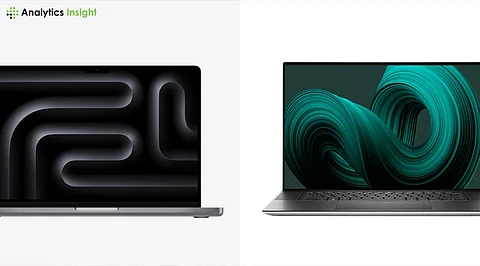

In today's world of high-performance laptops, two major options are Apple's MacBook Pro M3 and Dell's XPS 17. Both are designed for professionals and creative users, but they have different features. Let's compare their design, display, performance, battery life, connectivity, and price to see which one might be better for you.
The MacBook Pro M3 is all about that smooth, simple Apple vibe. It’s made from one solid piece of aluminum, which makes it feel fancy and tough. It’s about 2.14 kg (that’s like 4.72 lbs) and pretty thin at 355.7 x 248.1 x 16.8 mm. It’s easy to carry around, so if you’re always moving, it’s a win.
Then there’s the Dell XPS 17, it’s got a modern look too, but it’s bigger. They used aluminum and some carbon fiber to make it, and it weighs 2.31 kg (around 5.09 lbs). Its size is 374.45 x 248.05 x 19.5 mm, so it’s not as small, but the screen takes up almost the whole front because the edges are super thin like 90.2% of the front is just the screen. That makes watching stuff or working on it feel huge and cool.
The MacBook Pro M3 has a 16-inch screen called Liquid Retina XDR. It’s got a resolution of 3456 x 2234 pixels, which means everything looks super sharp. It uses Mini LED tech, so it gets really bright up to 600 nits, and the colors pop while the dark parts stay super dark. Plus, it’s got a 120Hz refresh rate, so everything moves smoothly. Perfect if you’re editing videos or drawing.
The Dell XPS 17 has a bigger 17-inch screen with a resolution of 3840 x 2400 pixels. It’s not as bright tops out at 500 nits but it’s still amazing for seeing details and getting colors right. If you need a big space to work on, this one’s got you covered.
Inside the MacBook Pro M3, there’s the M3 Pro or M3 Max chip, made with a tiny 3nm process. It can have up to 12 CPU cores and 38 GPU cores, so it’s crazy fast and doesn’t waste power. In tests like Geekbench 6, it scores 3061 for single-core stuff (like one task at a time) and 14579 for multi-core (lots of tasks together). It’s a beast for tough jobs.
The Dell XPS 17 runs on Intel’s 13th-gen Core chips—up to the Core i9-13900H—and pairs them with NVIDIA’s RTX 40-series graphics. That combo is great for things that need strong graphics, like games or 3D work. In the same Geekbench 6 test, it gets 2481 single-core and 11392 multi-cores. It’s solid, but the MacBook’s CPU beats it when you push it hard.
Battery life matters a lot if you’re out all day. The MacBook Pro M3 has a 100Wh battery, and since the M3 chip doesn’t eat up power, it lasts a super long time before you need to plug it in.
The XPS 17 has a 97Wh battery—not bad, but the Intel chip and NVIDIA graphics use more juice. If you’re doing heavy stuff, it might run out faster than the MacBook.
The MacBook Pro M3 gives you three Thunderbolt 4 ports, an HDMI 2.1, an SDXC card slot, and a headphone jack. That’s pretty good for plugging in monitors or cameras.
The XPS 17 has four Thunderbolt 4 ports, a full-size SD card slot, and a headphone jack. No HDMI, but they throw in an adapter for HDMI and USB-A, so you’re still set for most things.
The MacBook Pro M3 starts expensive because it’s got top-notch parts. You can tweak it with more RAM or storage, but it’ll cost you.
The Apple MacBook Pro M3 is available in India starting at ₹1,49,900 for the base model with 8GB RAM and a 512GB SSD.
Higher-end configurations, such as those with the M3 Pro chip, 18GB RAM, and 512GB storage, are priced at ₹1,94,900.
The Dell XPS 17 starts at ₹2,99,990 in India. A higher-end configuration featuring a 13th Gen Intel Core i9 processor, 32GB RAM, and a 1TB SSD is priced at ₹3,79,777.99.
The MacBook Pro M3 offers superior CPU performance, display quality, and battery life, making it ideal for users within the Apple ecosystem or those needing high performance. The Dell XPS 17 provides a larger screen, strong discrete graphics, and more configuration options, often at a lower price, appealing to users who prioritize these features. Both are excellent choices; your decision should align with your specific professional needs and preferred ecosystem.
